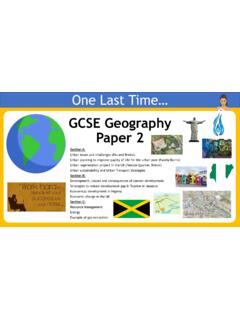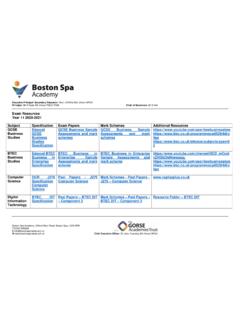Transcription of GCSE GEOGRAPHY REVISION CHECKLISTS
1 gcse GEOGRAPHY REVISION CHECKLISTS COURSE OUTLINE CS = Detailed Case Study (Minimum 4 lessons) & Eg = Detailed Example PAPER 1 Living with the PHYSICAL Environment Topics: Marks Exam Time: 1 hrs 88 marks in total Including 3 marks for SPaG (Spelling, punctuation & grammar) 35% of gcse mark Question styles: Multiple choice; Short answers; calculations; open response; extended written argument with evidenced point & informed conclusions. Section A Question 1: Challenge of NATURAL HAZARDS 1) Natural Hazards 2) Tectonic Hazards (Eg HIC & LIC contrasting Effects & Responses) 3) Weather Hazards a) Tropical Storms (Eg Effects & Responses) b) UK Extreme Weather (Eg Cause, Impact & Management) c) Climate Change 33 marks Answer all questions. Last question (9) is 9 marks plus 3 marks for SPaG. Section B Question 2: LIVING WORLD 1) Ecosystems (Eg Small scale UK ecosystem) 2) Tropical Rainforests (CS Causes of deforestation, Impacts & Issues) 3) Hot Deserts You are not studying this!
2 4) Cold Environments CS development opportunities & challenges 25 marks (9 marks for Cold Env) Answer all questions. Section C Questions 3-5: Physical LANDSCAPES in the UK Qu 3) UK Coastal Landscapes (Eg x2 Landform & management) Qu 4) UK River Landscapes (Eg x2 Landform & management) Qu 5) UK Glacial Landscapes Don t do! 30 marks (15 each) ONLY Question 3 & 4 PAPER 2 Challenges in the HUMAN Environment Topics: Marks Exam Time: 1 hrs 88 marks in total Including 3 marks for SPaG (Spelling, punctuation and grammar) 35% of gcse mark Question styles: Multiple choice; short-structured answers; cloze exercises, photo interpretation/ description, interpretation of maps on different scales, data responses, longer extended writing. Section A Question 1: URBAN Issues & Challenges 1) Urban World 2) Urban growth in LIC City (CS: Lagos Causes, opportunities & challenges. Eg Planning) 3) Urban Change in UK (CS: Importance, migration, opportunities & challenges.
3 Eg Regeneration) 4) Urban Sustainability 33 marks Answer all questions. Last question (8) is 9 marks plus 3 marks for SPaG. Section B Question 2: Changing ECONOMIC world 1) Global development gap 2) Reducing the global development gap (Eg) 3) NEE Rapid Economic development (CS) 4) UK Economic Futures (Eg Industrial sustainability) 30 marks Answer all questions. Section C Questions 3-5: Challenge of RESOURCE MANAGEMENT Qu 3) Resource Management (14 marks) Qu 4) food (11 marks with Eg Qu 5) Water Don t do! Qu 6) Energy Don t do! 25 marks Answer ONLY Question 3 & 4 PAPER 3 Geographical Applications: Marks Exam Time: 1 hrs 76 marks in total Including 6 marks for SPaG (Spelling, punctuation and grammar) 30% of gcse marks Section A: Issue Evaluation on Pre-Release material Questions based on pre-released material (12 wks before exam). Topics on any of the compulsory sections of Paper 1 & 2.
4 Critical thinking & problem solving & Geographical skills. 37 marks Answer all questions. Last question is 9 marks plus 3 marks for SPaG. Section B: Fieldwork on 2 compulsory human & physical topics (15% of final grade). Fieldwork to include the Enquiry process: 1) Identifying suitable question; 2) Select, measure & record data; 3) Process & Present data; 4) Describe, analyse & explain results; 5) Reach conclusions; 6) Evaluate geographical enquiry 39 marks Answer all questions. Last question is 9 marks plus 3 marks for SPaG. 0102030402010304 Geographical Skills are assessed across all 3 papers (Cartography: map graphs; numeracy; statistics; use of data). Your final grade is 10% on maths and statistical skills and 5% on spelling, punctuation & grammar (SPaG). gcse 9-1 AQA 8035 GEOGRAPHY PAPER 1 PHYSICAL GEOGRAPHY Living with the Physical Environment PAPER ONE UNIT A The Challenge of Natural Hazards Covered in class?
5 REVISION undertaken Natural hazards I can define a natural hazard and give some examples of the different types. I can explain the different factors that affect risk. Tectonic hazards I can describe the distribution of earthquakes and volcanoes. I explain the differences between destructive, constructive and conservative plate margins. I know the main features of an earthquake and two different ways of measuring earthquakes. Using named examples of a tectonic hazard in both rich and poor countries. I can: (1) Explain why the tectonic hazard happened there, (2) Describe the effects that resulted from the earthquakes both primary and secondary. (3) Describe what was done after the earthquake (responses), both in the long and short term. I can explain why earthquakes cause more loss of life in poor than in rich countries. I can explain why people continue to live in areas at risk of tectonic hazards.
6 I can explain how monitoring, planning and prediction of tectonic hazards can reduce their effects. Weather hazard I can describe the global atmospheric circulation model. I can explain how the global atmospheric circulation model affects weather around the world. I can describe the distribution of tropical storms. I can explain the causes of a tropical storm. Using a named example I can describe and explain the primary and secondary impacts of tropical storms. I can assess and evaluate methods of responses tropical storms in both the long and the short term using a named example. I can explain how tropical storms might be affected by global warming. I can explain how monitoring, planning and prediction of tropical storms can reduce their effects. I can explain the cause of an extreme weather event using an example. I can describe and expel the social, economic and environmental using an example.
7 I can identify evidence of the weather becoming more extreme using an example. I can explain how extreme events can be managed to reduce the impacts. I can assess and evaluate the impact that weather conditions have upon people homes, lives, agriculture, health and transport. Climate change I can explain the evidence both for and against climate change. I can explain both the natural and human causes of climate change. I can assess and evaluate the economic, social, environmental and political impacts of climate change both on the world and the UK. I can describe and evaluate the mitigation strategies used to reduce the impact of global climate change on a local, national and international level. I can describe and evaluate the adaption strategies used to reduce the impact of global climate change on a local, national and international level. PAPER ONE UNIT B The Living world Covered in class?
8 REVISION undertaken Using an example from the UK, I can explain the interrelationship within the natural system. I can define and give UK examples of producers consumers, decomposer, food chain, food web and nutrient cycle I can explain their interdependence of each of the above and explain how changes might affect each other. I can describe the distribution and characteristics of global ecosystems around the world. Tropical rainforests (core content) I can describe the physical characteristics of the tropical rainforests I can explain the interdependence of the climate, water, soils, plants, animals and people in a tropical rainforest I can explain how plants and animals have adapted to the physical conditions of tropical rainforests. I can describe and explain the problems and issues with changing biodiversity within the tropical rainforest. I can describe and explain the changing rates of deforestation.
9 I can use a case study to explain the causes of deforestation subsistence and commercial farming, 1. Logging, 2. Road Building 3. Mineral Extraction 4. Energy Development, 5. Settlement 6. Population Growth I can use a case study to explain the impacts of deforestation 1. Economic development 2. Soil erosion, 3. Contribution to climate change. I can explain the importance and value of the tropical rainforest on a local, national and international scale. I can explain why it is important the tropical rainforest should be managed sustainably. I can explain how the tropical rainforest can be managed sustainably using a range of methods 1. Selective logging and replanting 2. Conservation and education 3. Ecotourism 4. International agreements about the use of tropical hardwoods, 5. Debt reduction. Cold Environment (option) I can describe the physical characteristics of the cold environment I can explain the interdependence of the climate, water, soils, plants, animals and people in a cold environment I can explain how plants and animals have adapted to the physical conditions of cold environments.
10 I can describe and explain the problems and issues with changing biodiversity within the cold environment. I can use a case study to explain developments in cold environments. 1. Mineral Extraction 2. Energy Development 3. Fishing 4. Tourism I can use a case study to explain the challenges of developments in cold environments. 1. Extreme temperature 2. Construction 3. Services 4. Inaccessibility I can describe and explain why developments in cold environments causes issues. I can describe and explain why cold environments need protecting. I can explain how cold environments can be managed using: 1. Using appropriate technology 2. Action by governments 3. Conservation PAPER ONE UNIT C Physical Landscapes in the UK Covered in class? REVISION undertaken I can describe the location of the major upland and lowland areas within the UK I can describe the location of the major river systems within the UK Coastal landscapes of the UK I can define what the coast is I can describe and explain the different types of waves I can name and explain the four processes of erosion I can name and explain the processes of weathering I can name and explain the processes of mass movement I can describe erosional landforms and the sequence of (arch, caves, stacks, stump, wave cut platforms, wave cut notch) are formed.







